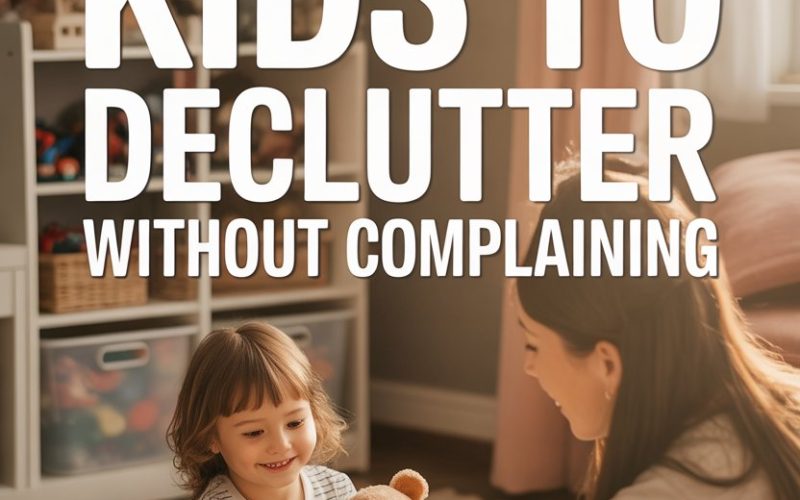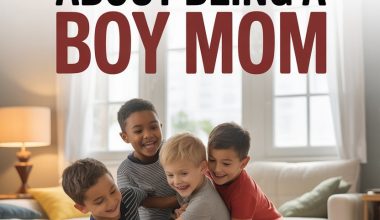Clutter. It multiplies in dark corners and under beds faster than socks disappear in the laundry.
And when it comes time for a tidy‑up, kids seem to sprout Olympic‑level creativity for avoiding the task—suddenly, they’re “too tired,” “too busy,” or “too invested in staring at the ceiling.”
If you’ve ever found yourself brokering complex negotiations over a pile of broken crayons, you’re in good company.
Luckily, there are ways to get kids to declutter their rooms, toy baskets, or artwork piles without turning the whole experience into a battleground. It’s all about working smarter, not harder.
Start With the Why, Not Just the What
Young minds are natural question factories. “Why do I have to?” is far more common than “Where should I start?”
Instead of launching straight into a decluttering session with a bin bag and a bracing sigh, take a moment to explain. Kids are more likely to get on board when they know the reason behind the madness.
Bring them into the conversation: “You know, when we clear out some of these toys, it’s a lot easier to find your favourites.” Or, “When there’s less stuff on the floor, there’s more room for that epic Lego city you want to build.”
Framing decluttering as a way to make life more fun and manageable can win over even the most reluctant participants.
Make It a Game, Not a Chore
Who says tidying up can’t be fun? Okay, your kids might. But hear me out.
Turning decluttering into a challenge can transform groaning into giggling. Try “The 10‑Minute Dash,” where everyone races to see how much can be sorted in just ten minutes.
Or “The Treasure Hunt,” where the goal is to find and put away as many hidden socks, marbles, or action figures as possible.
For some families, “Keep or Toss” becomes a goofy version of a talk show—one person holds up items and the rest vote on their fate.
You might be surprised how enthusiastically your youngest gives an old, broken toy the boot when there’s an audience involved.
Start Small and Build Momentum
Announcing, “We’re cleaning your whole room today!” is a surefire way to spark protests. Instead, break the job down into bite‑size pieces. Pick one shelf, one drawer, or even one basket to sort at a time.
Progress feels far less overwhelming when it’s measured in manageable chunks.
Even better, when kids see how quickly a single area can be transformed, they’re often more willing to tackle another. Momentum is a wonderful thing—just don’t tell them you planned it that way.
Let Kids Take the Lead
Everyone wants a say over their own stuff, even little ones. Allowing kids to make choices about what stays and what goes boosts their sense of ownership—and can cut down on complaints.
Offer guidance when needed (“Do you still use this, or has it been living under your bed since last summer?”), but try not to overrule every decision.
If your child insists on keeping a bouncy‑ball collection that’s threatening to take over, consider designating a specific container. When it’s full, it’s time to reassess.
Create Clear, Kid‑Friendly Systems
If you want decluttering to stick, bins labelled “Keep,” “Give Away,” and “Recycle” (bonus points for colourful stickers or doodles) can work wonders.
Young children, especially, are more likely to sort their things when the system makes sense to them.
Older kids might appreciate a “Maybe” pile for items they’re on the fence about. Sometimes, just knowing there’s no forced march to the charity shop helps ease the anxiety.
Make sure storage solutions are within reach—literally. There’s little point in expecting a six‑year‑old to use a shelf that requires a ladder.
Schedule Regular Declutter Sessions—But Keep Them Short
Waiting until the floor has vanished beneath a mountain of plushies and puzzle pieces? That’s a recipe for foot injuries and family arguments.
Short, routine clear‑outs work far better. Mark them on the calendar—monthly, fortnightly, whatever fits your family rhythm.
Keep sessions brief. Ten to twenty minutes is plenty for most ages, especially if you bring music or a silly timer into the mix.
When tidying becomes as regular as pizza night or Saturday‑morning cartoons, it loses its power to spark dread.
Give Items a Second Life
Kids often struggle to let go of toys, clothes, or books because they worry about where those belongings will end up. Instead of focusing on getting rid of stuff, talk about how items can be loved by someone else.
If possible, involve your child in choosing a local charity or shelter where toys or clothes might be appreciated. Some children love the idea of passing their picture books on to a younger cousin or neighbour.
Research from the University of British Columbia shows children are more cooperative when they understand the social impact of their efforts.
It’s a lot easier to part with that fifth teddy bear when it’s going to “a kid who doesn’t have any teddies at all.”
Model Decluttering Yourself
Little eyes are always watching. If you clutch every outgrown jumper or ancient magazine as though it’s a family heirloom, don’t be surprised if your offspring develop similar habits.
Let children see you sorting through your own things and making choices about what to keep. Narrate your process: “I loved this mug, but it’s got a chip, and now I’m finding it a new home in the recycling.”
You’re not just telling them what to do—you’re showing them.
Reward Progress Along the Way
No need to shower kids with presents every time they fill a bag for the op shop. But a little positive reinforcement goes a long way.
Offer plenty of praise, and maybe a small treat (extra story at bedtime, a favourite snack) when a job is well done. Some families use sticker charts or points toward a bigger reward, like a family movie night.
The key here? Make the reward about effort and teamwork, not about getting rid of the most stuff.
Be Patient—And Keep Perspective
Some children are natural minimalists; others seem destined for future appearances on “Hoarders.” If your child is particularly attached to their belongings, it may take several rounds before decluttering feels routine.
Don’t expect perfection. A tidy room today may be right back to chaos tomorrow, especially during busy weeks or in the middle of a creative streak.
The aim isn’t to achieve a show‑home, but to help kids learn to manage their space—and, hopefully, stop tripping over rogue Lego bricks in the dark.
When Meltdowns Happen
Occasionally, decluttering unearths more than just forgotten toys. Tears, tantrums, or sudden refusals might signal that a child is feeling overwhelmed or anxious about change. That’s normal.
Give them space. Offer comfort, and try again another day. For some kids, starting with just one or two items and building from there is all they can handle. It’s not a race.
If you sense that sentimental attachments are running particularly deep or that your child’s anxiety around decluttering is part of a broader pattern, consider reaching out for guidance from a paediatrician or child psychologist—resources like the American Academy of Pediatrics offer practical tips and support.
Building Lifelong Habits
A home free from constant clutter isn’t just easier to clean (though that’s a massive bonus). It’s also a gift for your child: a space where they can play, create, and rest—without being buried by their own stuff.
Encouraging kids to declutter doesn’t mean stripping away everything they love. It’s about helping them learn what they value, how to let go gracefully, and that a tidy space can feel pretty lovely.
And if all else fails, remember—one man’s “junk drawer” is another kid’s pirate treasure chest. Just try not to step on it in the middle of the night.





